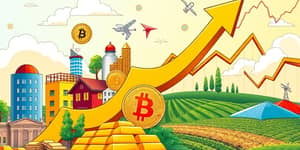
Interest rates shape the financial landscape for consumers, businesses, and governments alike. Under the surface of headline rate announcements, persistent high inflation in essentials erodes real salaries, and even modest rate adjustments can send ripples through markets and households. By exploring both direct impacts and subtle aftershocks, we uncover how these policy tools influence decisions from the family budget to global trade.
As of early 2025, volatility has eased and key indicators are gravitating toward pre-pandemic norms. Notably, the yield curve has uninverted, a shift that signals improved confidence among investors and lenders. Where an inverted curve once raised recession alarms, normalization now suggests sustained growth prospects.
Despite this positive sign, inflation remains sticky at elevated levels. Essentials like housing, food, and utilities show little disinflation, creating pressure on disposable income. Meanwhile, consumer spending growth is expected to decelerate, particularly in retail, travel, and entertainment sectors that rely on discretionary outlays.
Central banks use interest rates to steer economic activity. Lower rates typically spur borrowing for homes and autos by making credit cheaper, while higher rates prompt both consumers and businesses to curb spending. In June 2025, 30-year mortgage rates at about 6.8% have discouraged new homebuyers, cooling residential markets across the country.
Looking ahead, the Federal Reserve is expected to cut rates by 25 basis points each quarter starting Q3 2025, assuming inflation trends improve. However, rising trade tensions—such as higher U.S. tariffs on Chinese imports—could push long-term yields above 5%, jeopardizing government finances and forcing fiscal tightening.
Geopolitical shifts amplify rate effects. Tariff hikes raise import costs, feeding back into inflation. At the same time, elevated global yields can attract foreign capital, strengthening the dollar and weighing on exports. Policymakers must balance these forces to maintain growth without reigniting price pressures.
Beyond direct borrowing costs, higher interest rates reshape consumer behavior and market dynamics. Many households find that real household purchasing power is suppressed despite modest wage gains, leading to hesitancy over non-essential purchases and travel plans.
In the financial system, sustained higher returns on bonds entice risk-averse investors away from equities, triggering sector rotations. Financial institutions often thrive with wider interest spreads, while growth and discretionary sectors suffer as valuations contract. This capital reallocation can intensify volatility in stock markets.
The following table captures essential statistics underpinning the current environment.
Looking beyond the current cycle, structural shifts in lending may leave lasting impacts on small enterprises and first-time homeowners. Conversely, savers enjoy improved deposit returns, creating a silver lining for those holding cash or bond portfolios.
As the Fed navigates between inflation control and growth support, individuals and businesses must remain agile. By understanding these hidden effects—beyond the straightforward cost of borrowing—stakeholders can make informed choices, hedge risks, and seize opportunities when the tide of interest rates turns.
References













